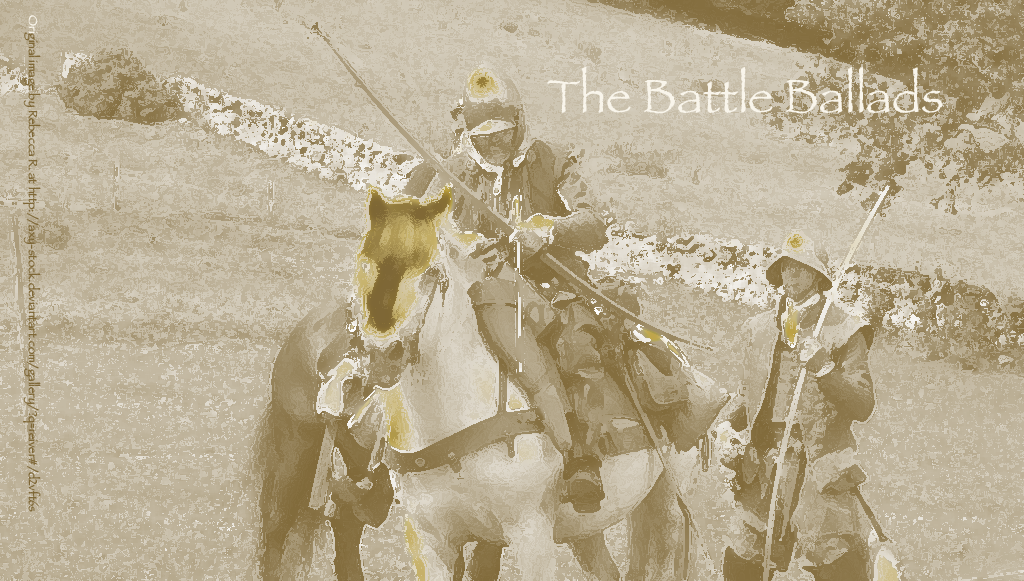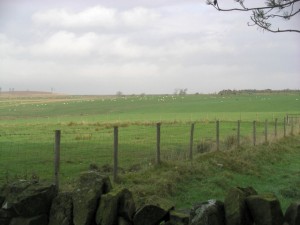The Battle of Otterbourne
The version of “The Battle of Otterbourne” we have chosen for the site is the one which first appeared in the 1803 edition of the Minstrelsy of the Scottish Border. In the 1802 edition, Scott presented a version of the ballad which had already been published in David Herd's Ancient and Modern Scottish Songs, Heroic Ballads Etc. In that version, Earl Douglas is murdered by a resentful servant.
However, the version which appears in the 1803 edition presents Earl Douglas being killed on the battlefield. This has more in common with the version Scott would have known from Bishop Percy's Reliques of Ancient Poetry, first published in 1765, although that particular version is more sympathetic to the English cause, rather than that of the Scots. When the ballad is sung by contemporary singers, they almost always present a version where the Douglas is killed on the battlefield.
The ballad presents an account of the Battle of Otterburn. It includes the names of some of the prominent people who were known to have fought in the battle, a list of locations which are relevant to the area in which the battle was fought, and is very specific regarding date, time and what happened. It is very easy to assume, then, that history is being presented by the ballad. However, it is primarily a form of entertainment, and cannot be used as an historical source. It may be, though, that a ballad can reflect a personal opinion or a generally accepted account of an incident, or statements contained can be corroborated by other documentary evidence.
History
The Battle of Otterburn was fought on the 5th August 1388. At that time, there was a precarious peace between Scotland and England. The Border area suffered as the ruling factions and families on both sides of the Border lines raided and counter-raided in order to advance their own status and causes in political circles. Relations between the two kingdoms had been deteriorating for years: on the English side, there had been the loss of lands around the Lothians and the non-payment of the majority of the ransom which had been set for the release of King David II of Scotland, who had been held in England for 11 years after his capture after the Battle of Neville’s Cross in 1346. David II had died in 1371 and King Robert II was no position – or of any disposition – to settle the outstanding ransom, return lands or to willingly acquiesce to any demands from the English King Richard II. Instead, he began to fortify strongholds and entered into agreements with the French.
Land and property on both sides of the Border suffered. While Robert II had his own power-hungry nobles to control, Richard II had troubles of his own. The Scots took advantage and launched a triple-headed attack into the English West and East Marches on the Border, and into Ireland. The East March raid was led by James, 2nd Earl of Douglas, who drove on as far South as Durham, burning and raiding as they went. Henry Percy was dispatched to cut the Scots off on their return.
The forces skirmished around Newcastle and Percy lost his pennon. It is this act, which provides the source for many tales and ballads. It is said that Douglas, in the spirit of chivalry, offered Percy the opportunity to regain his pennon, and that is why the Scots halted at Otterburn, to allow Percy and his force to meet in battle. A more pragmatic approach may be that Percy pursued the Scottish force, realising that the numbers were small enough for his own men to engage in battle. In addition, Percy would have been bound to defend his own Marches and it is logical that he would pursue a hostile force.
The Scots made camp at Otterburn, not being able to take the castle there. Irrespective of whether they waited out of a chivalric reason, to allow the troops to rest before joining up with those who had invaded the West March, or, realising there was a pursuing army, waited to counter any attack, they were relatively unprepared when the English attacked.
Instead of running, as may have been expected, the Scots quickly organised and counter-attacked, fighting on through the night. James Douglas died on the field, but this was concealed from his men, due to the night-time conditions. The Scots gained the upper hand, killing, it is estimated, over 1000 english soldiers and capturing 22 English knights, Henry Percy among them. It was not, however, a rout: around 200 Scots were captured when they pursued the retreating English forces. The ballads concerned with this battle – “The Battle of Otterbourn” and “The Chevy Chase” – concentrate on the chivalric versions of the skirmish and subsequent battle.
You can read about Battle of Otterburn on the English Heritage site and the Battlefields Trust site.
Some of the political decision making, which led to Otterburn, came about after the Scottish defeat at the Battle of Neville’s Cross, some 42 years before Otterburn. You can read more about that battle here.
The Characters
Earl of Douglas – James, 2nd Earl Douglas (c. 1358 – August 1388)
James Douglas was a celebrated Scottish knight. His father was nephew to “Good Sir James”, Robert the Bruce’s famous deputy. In 1380, his father made over land in Liddesdale to James, and by that time, he had been knighted, as he was known as Sir James Douglas of Liddesdale. He was part of the Black Douglas faction, who were powerful landowners and one of the dominant families in Scotland – a dominance which came crashing to an end in the Fifteenth Century, with the Battle of Arkinholm. He was husband to Princess Isabel, daughter of King Robert II of Scotland, in a politically expedient match, which reconciled the Douglases to the monarch’s cause. He seems to have been an impulsive, adventurous individual, who perhaps fulfilled many of the notions regard chivalric knighthood. He led several raiding parties into the North of England in the years before Otterburn, and was experienced in the Scottish tactics of invasion, retreat and laying waste the land. Tradition says that he fought hand-to-hand with Henry Percy, “Hotspur”, during the Scots skirmishes at Newcastle, where he won the English knight’s pennon. However, a few days later at Otterburn, while his forces won the day, and Percy was captured, the Earl of Douglas was killed on the battlefield.
You can read more about James Douglas here.
(www.oxford.dnb.com can be accessed via public libraries and academic institutions)
The Gordons
Although this clan is now associated with the North-East of Scotland, they originally held land around what is now Berwickshire. According to Scott, their first charter for Strathbogie in the North-East was presented to John de Gordon by King Robert II, in 1376.This Border connection is corroborated not only in documentation, but in early poetry, such as in Andrew of Wyntoun’s Orygynale Cronykil of Scotland.
The Grahams
The Graham family have long Border connections.While the English-based reivers are those most commonly referred to, there were also more aristocratic lines.
Sir David Graham of Kincardine was one of the Scottish lords who negotiated the ransom by the English of Scotland’s King David II. In 1373, he swore fealty to King Robert II. The reference in the ballad may refer to those Montrose Grahams, or it may be that the Border Grahams, in a time when fidelity to either the Scottish or English monarch could be seen as flexible, came out for the Scots.
The Lindesays
This refers to the troops led by David, Lord Lindsay, who accompanied the Douglas on several of his previous raiding expeditions. He survived Otterburn and the more bloody Battle of Homildon Hill, which was fought in 1402.
The Jardines
Tradition would have people believe that the Jardine clan – a West Border clan – would not ride with the Douglas. Scott, as explanation, suggests that “this was the result of one of those perpetual feuds, which usually rent to pieces a Scottish army”. With no other strong explanation, this is a valid one. By the Fourteenth Century, the clan had settled around Applegarth, in Dumfriesshire.
Lord Percy
Sir Henry Percy “Hotspur” (1364 – 1403)
Sir Henry Percy was perhaps even more of an exuberant and impulsive character the James Douglas. Born on 20th May 1364 in Alnwick Castle, he was knighted in 1377 and took part in several campaigns throughout Europe and beyond. He served as the English East March Warden and it was on the Border that he gained his nickname: it would seem that it was afforded to him by Scottish opponents. Although he had either relinquished or had been forced to surrender the position of March Warden in 1386, he was once again Warden in 1388, and it was partly in that capacity, partly through his own methods of warfare, that he pursued the Douglas’s force to Otterburn. However, despite his forces surprising the Scots army, he and his men were Captured at Otterburn, with his ransom being set at 7000 merks. This was paid by a combination of royal gift and parliamentary subscription, which suggests the esteem in which he was held, and he was at liberty by the Summer of 1389.
You can read more about Henry Percy here.
(www.oxford.dnb.com can be accessed via public libraries and academic institutions)
Sir Hugh Montgomery
The Montgomeries were certainly at Otterburn, although it was Sir John de Montgomerie who captured Henry Percy. Sir Hugh Montgomerie, his son, was killed in the battle
______________________________________
Image of the site of Otterburn:
© Copyright Graham Ellis and licensed for reuse under this Creative Commons Licence.

